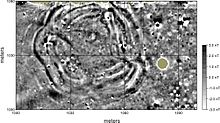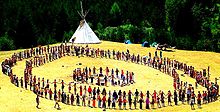- Council circle
-
A council circle is a distinctive archological and architectrual artifact that is found at the center of some tribal villages in North America. The historical function of the council circles is debated by experts. Some suggest that the talking circles are ceremonial, and others support a hypothesis that they were places for political discussion that suggest "aboriginal democracy."
In current use, the council circle is often synoymous with the talking circle, and is a means of group communication that promotes input from all the members[1]. A talking stick, or other significant or impromptu object, is passed around the circle, and only the circle member holding the stick is allowed to speak, though he or she may allow others to interject. This is the preferred type of forum for many present-day tribes as well as groups such as the Rainbow Gatherings that revive tribal life.
In this Edward S. Curtis photograph, a Kwakwaka'wakw tribesman is shown with a talking stick.
The present-day use of the talking sticks suggests to many that talking sticks, in the context of the council circle, present evidence of historical and pre-historical use by native tribes to create egalitarian forums. From photographs, we know that talking sticks where very tall, suggesting that circle particpants would have stood when speaking[1].
Present-day talking circles
As described in many web sites, a talking circle is used as a way to organize group discussions in an "egalitarian" manner. Group members typically sit in a circle and discuss issues with simple rules: the talking stick, or other object, is passed around the circle, and the person holding the talking stick may speak though the "holder" may allow interjection.
Sources
Text citations
- ^ "Exploring Native American Wisdom ... - Fran Dancing Feather, Rita Robinson - Google Books". Books.google.com. 2002-12-30. http://books.google.com/books?id=DyeI1e92d-QC&pg=PA113&lpg=PA113&dq=council+fire+council+circle+talking+circle&source=bl&ots=2ZH1JIXQMc&sig=X7vUYm_qxREeQ_XQGSWdaxXBP-0&hl=en&ei=x0ycTv23EcP10gGlw4CsBA&sa=X&oi=book_result&ct=result&resnum=1&ved=0CB0Q6AEwAA#v=onepage&q=council%20fire%20council%20circle%20talking%20circle&f=false. Retrieved 2011-10-17.
Other citable sources
-
- Talking Circles by Mark Umbreit, 2003, source
-
- A guide to facilitating Ojibwe and Lakota talking circle traditions much like group therapy.
-
- Modern applications to group work by Kevin A. Fall and Justin E. Levitov, 2000, source
-
- Application of the Cherokee Do-ne-la-we-ga or "coming together" to children's group therapy.
-
- Cultural anthropology: the human challenge, William A. Haviland, Harald E. L. Prins, and Dana Walrath, 2007, source
-
- The restoration of the traditional council circle to replace the modern justice system.
- Researching the culture in agri-culture by Michael M. Cernea, and Amir H. Kassam, 2005, source
-
- Talking circle and stick in an Indonesian native forest project.
Popular sources

This sociology-related article is a stub. You can help Wikipedia by expanding it.



